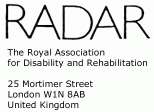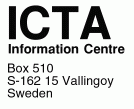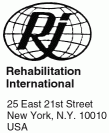Disability knows no boundaries; and disaled people throughout the world find barriers in the planned environment which restrict independence
Planning guidelines
It is important that those who develop policies for the planning of cities and buildings should take account of the needs of disabled people.
Whilst acknowledging that there will be differing economic,social and cultural situations prevailing in many parts of the world and that building laws and regulations will undoubtedly vary, we would suggest the principles governing provision for the disabled are similar.
For that reason the following ICTA Guidelines do not lay down precise design standards, but rather point to those situations in the planned environment which need to be drawn to the attention of those who initiate and construct buildings.
Outside and around buildings
- Pedestrian routes in open spaces or between buildings should be free from obstructions, and pathways should be wide enough for wheelchair users. Surfaces should be slip-resistant.
- Where there are changes in level, shallow ramps should be provided in addition to steps and stairways which are clearly marked, and provided with handrails.
- Street furniture, bollards, gulley gratings and signposts need careful siting as they can be hazardous. Public toilets for disabled people should be sited where they are accessible and usable.
Parking and moving to buildings
- A place to park adjacent to a building or complex is essential for disabled passengers as well as for disabled drivers.
- Parking bays should be sufficiently wide to allow access for wheelchairs.
- A route from a parking place to a building should be level or ramped and unimpeded by steps.
Who are the disabled?
People with impaired hearing or sight, people who for a number of reasons cannot walk easily and people who have to use wheelchairs often encounter difficulties because of man-made handicapping features in the environment.
Disabled people want and are entitled to enjoy the same choice of activity and freedom of access that the able-bodied enjoy, but the additional handicaps we superimpose on their disabilities often prevent this.
The additional handicappes; architectural, attitudinal and other barriers, can force disabled people to have to resort to segregated arrangements when what they want to do is participate with others in normal living. They can dictate to disabled people which shop, library or post office they can use, which play, film or concert they can enjoy, which school or evening class they can attend, the job they can take and even whether they can work at all. They can dictate to disabled people when and how - and whether - they do what able-bodied people do.
Entrance to buildings
- An entrance to a building should be easy to distinguish and should preferably be under cover
- The access should be level and the door easy to open and wide enough to permit entry of a wheelchair. Revolving doors and frameless glass doors are hazardous.
Inside the building
- Inside the building, floor surfaces should be slip-resistant.Where there are changes in level, ramps should be provided as well as steps or stairways which are clearly marked.
- Where a building is multi-storey, a lift with controls that are usable from a seated position should serve all main circulation areas which provide facilities. It should be large enough for a wheelchair and one other person.
- Amenities for example, lavatories and telephones should be clearly signposted and usable.
What can be done?
Many of the barriers are unnecessary. Many can be avoided at little or no cost when buildings and their surroundings are designed. Many others can be removed without trouble During adaptations and renovation.
Many of the features that make the built environment accessible to and convenient for the use of disabled people also make it better for others, including the majority who are not athletic; mothers with children in prams, people whose sight or hearing is not perfect, and the elderly and infirm. The following guidelines highlight features of the environment which if incorporated will make a great deal of difference to the independence of wheelchair users and other disabled people. The size of the building together with an estimate of its anticipated use by disabled people will influence the type of provision that is required.
Visual, audible and tactile aids.
- A building will be easier to use where signposting is legible, well illuminated and where lettering and numerals are embossed or raised. Names and numerals on doors should be at eye level.
- A building will be easier to use where there is a loudspeaker system, inductive loop system and where audible signals are interlinked with visual signals. Switches and environmental controls must not be out of the reach of people who use wheelchairs.
- A contrast in colour, distinguishing routes and parts of buildings, together with changes in floor texture where there are hazards, will assist the blind and visually impaired.
Safety
- A known and well managed scheme to assist disabled people moving from buidlings in na emergency will eliminate much of the prejudice which often bars persons from getting into buildings.
Reminders
- Some disabled people rely on handrails or sticks, wheelchairs and guide dogs, essential aids in their ability to use buildings. No one should be barred on account of disability from entering a place which has been designated for public use.
References
ISO Functional Needs of Handicapped People in Buildings -
Design Guidelines, Part I
ICTA Archtectual Facilities for the Disabled
RI Barrier Free Design
UK Report by the Silver Jubilee Committee on Improving Access for Disabled People
Acknowledgements
C.WYCLIFFE NOBLE OBE FRIBA
Consultant Architect to
The Royal Association for Disablity and Rehabilitation UK.
(C) C. Wycliffe Noble RADAR 1983
This document may be translated into other languages by prior permision

|

|

|
